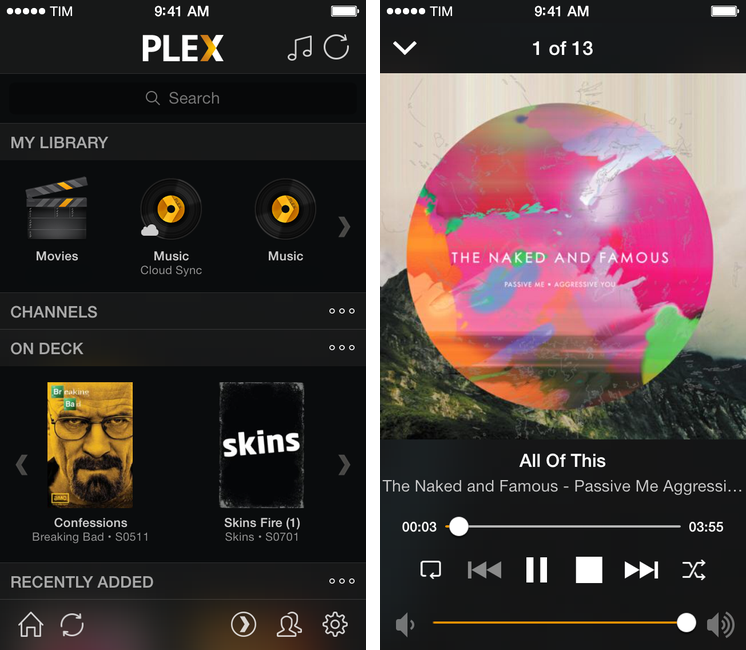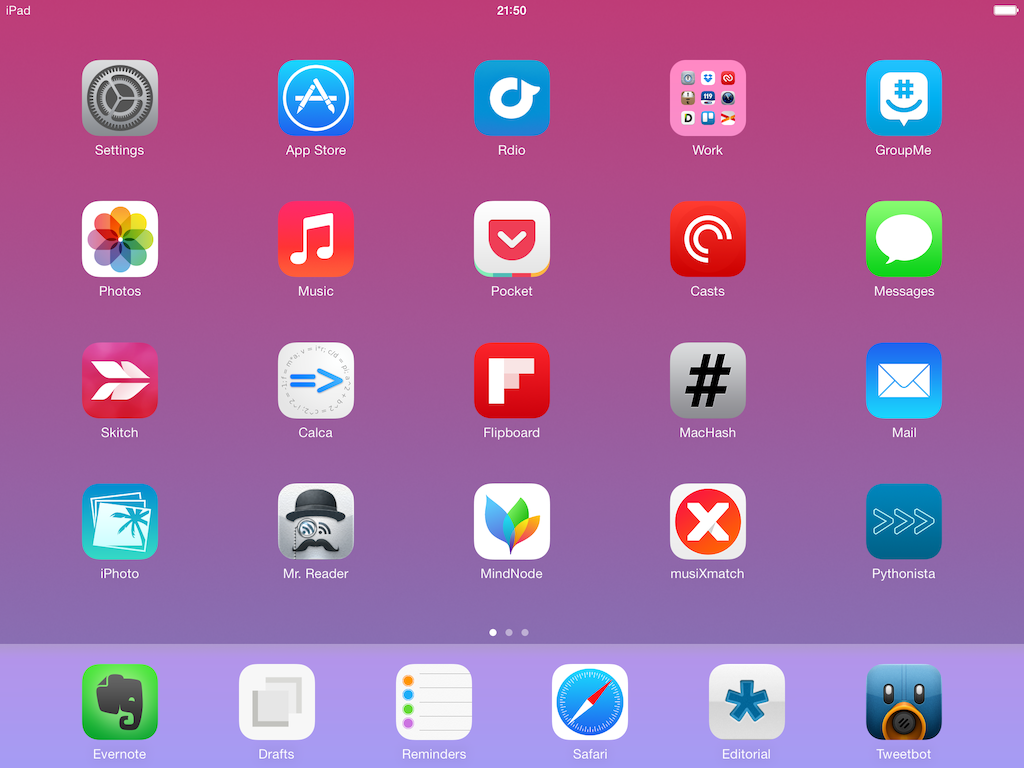Mr. Reader, my favorite RSS reader for iPad and one of my must-have iPad apps, has been updated to version 3.0, which brings a (subtle) redesign for iOS 7, background downloads, Reading List support, and more. Mr. Reader 3.0 is a free update on the App Store. Read more
Mr. Reader 3.0 Updated for iOS 7 with Background Downloads, Reading List Support
The Prompt: A Skilled Keypunch Operator→
This week, the young men of The Prompt are taught many things by the good Dr. Drang.
Topics include punched cards, Macintosh bags, and iPads. Get the episode here.
Brought to you by two great sponsors:
- Squarespace (use code TALLYHO12 for 10% off)
- Hostgator (use code PROMPT12 for 30% off)
Plex Gets iOS 7 Update
Plex for iOS, a native client for the company’s media manager, has been updated today with support for iOS 7. Version 3.3, available on the App Store, introduces a tweaked look to match Apple’s new OS, as well as bug fixes and changes to the media player.
The app hasn’t been revolutionized in its transition to iOS 7: the main screen has stayed the same, with sections to access your library, channels, and media that is either on deck or has been recently added to your Plex. There are no new options in the Settings, which still allow you to log into your myPlex account and configure playback preferences for synced and remote media.
There’s been, however, a general clean-up of the UI: gone are iOS 6 toolbars and buttons, leaving room for translucencies, redesigned icons, and simplified navigation bars. Translucencies are especially fitting as they make colorful media artwork show through the interface, but it still feels like Plex could use a major redesign (particularly on the iPad) as it has remained largely unchanged since 2011. According to the developers, “lots more user interface improvements” are coming.
The media player (pictured above) has been updated, and the app is now capable of recognizing URLs in the clipboard upon launch, so that you’ll have a shortcut to quickly put content from the web in your Plex queue.
You can get Plex 3.3 on the App Store. Last week, the company released (after a long beta period) version 1.0 of Plex Home Theater, a Mac app to access your Plex content without having to use Plex/Web.
Skitch for iOS Brings Back PDF Reading and Markup in Latest Update→
Skitch is great for marking up images and annotating documents, and it’s brought PDF reading and markup back from the dead. You’ll need to be an Evernote Premium subscriber to take advantage of PDF markup, but regular Skitch users can enjoy general enhancements and bug improvements. From iTunes:
Hey, here’s what’s new in this release
- PDF reading is back. Open a PDF in Skitch.
- Markup a PDF is back. Requires an Evernote Premium account.
- Web capture has been added back
- Improved crop mode
- Lots of bugs were crushed (no actual bugs were harmed)
Previously, Skitch added a crop function to their iOS app, and improved integration with Evernote for choosing a default notebook to save to.
Grab the latest update from the App Store.
Beats Music Coming in January, Reserve Your Username Today→
If you can’t settle with Rdio, find a happy home at Spotify, or are satisfied with Google Play Music All Access, there’s a new music streaming service coming from the same guys who make those bass heavy Beats headphones. Matt Panzarino at TechCrunch writes:
… It’s in an internal, private beta with ‘people who know and love music’. It’s also rolled out to some ‘artists and other influencers’ in order to get feedback, so celebs are playing with it as we speak. Rogers says they’re tweaking the service based on the feedback that they’re getting, and re-iterates that the service is set to launch in January.
If you want to grab your username, sign up here.
How does a streaming service like this differentiate? Do you make a service and launch with mobile apps that give you the most options like Rdio and Google, or differentiate in a specific way as Spotify does with playlists, Spotify Apps, and sharing? Considering who’s behind the project, I’m both curious and excited to see the end result.
Pod Wrangler on the Web→
David Smith’s lightweight podcast app now has a web companion in beta.
Today I’m rolling out a beta version of website integration for Pod Wrangler right on feedwrangler.net. You can now listen to your podcasts from within any modern browser. Playback position is synced up with Pod Wrangler so you shouldn’t need to fuss with finding your place. This works great for finishing off that episode you were listening to on your drive into work or in a context when you just can’t use your iPhone.
If you don’t like listening to podcasts in iTunes or in Apple’s Podcast app, give Pod Wrangler a try. It’s not an app that’s big on looks, but it’s fast and functional. If you run or listen to podcasts on your daily commute, Pod Wrangler recently added On-the-Go which makes playback controls big and easy to tap. You’ll have to become a full member by making an in-app purchase in the iPhone app to gain access to the web version, but being able to listen to your favorite podcasts from any of your desktops and laptops is really nice.
iBeacons as a Mechanism to Push Newsstand Publications→
Darrell Etherington from TechCrunch writes about how iBeacons are being used to sell digital magazines. Here’s a clever idea:
The tech is very handy in a number of scenarios, as in a coffee shop for instance, where the establishment could subscribe and enable access to full magazines to patrons who come in. It’s made even more convenient with the addition of iBeacons on iOS, as the whole digital handshake can happen automatically, providing the user with the best possible and most frictionless experience. Another possible use is in modernizing the doctor’s office, offering up publications in the waiting room that are more useful and more current than five-year old issues of Good Housekeeping.
On Relaxing App Store Rules→
Marco Tabini of Macworld uses the recent TextExpander touch debacle to the make the argument on why App Store rules should be relaxed.
On OS X, TextExpander can interact with just about any app. On iOS, Apple’s sandboxing makes this much harder, but in the past Smile’s developers have circumvented the problem by implementing a software development kit that other programmers can easily and quickly integrate into their own software.
Unfortunately, this leaves one problem unsolved: Third-party apps still need to synchronize their text-snippet database against the main TextExpander app, which is difficult to accomplish in an environment where programs are largely prevented from talking to one another—or even being aware of one another’s presence on the device.
Thus, Smile had to find another workaround, which involved relying on iOS’s built-in Reminders as an ersatz synchronization mechanism. After initially permitting that usage, Apple eventually rejected it as an improper application of a technology whose primary goal is, after all, to help you compile grocery lists.
My Must-Have iPad Apps, 2013 Edition
For the past three years, I’ve been running a series called “My Must-Have Mac Apps” that, once a year, would list the apps that I found indispensable on my Mac. This year, considering the changes that I went through from a workflow perspective, I thought it would be appropriate to start focusing on iOS as well. I’d like to start with the iPad.
I’ve been working primarily from my iPad for the past 15 months. For a variety of personal reasons that I’ve discussed before, I found myself unable to work from my Mac every day, so I decided to try and see whether the iPad and iOS could be viable OS X replacements – not just companions. I ended up enjoying the iPad as a work device and, eventually, as a primary device powered by terrific apps that allow me to be more efficient on iOS.
From a high-level, conceptual standpoint, this isn’t a new topic for MacStories readers or listeners of The Prompt. In the end, though, it all comes down to the apps – the software that I use on my iPad for work and play, for productivity and entertainment.
Hence, “My Must-Have iPad Apps”. I consider this the first installment, even though it technically isn’t: I published similar articles in 2010 and 2011, but I skipped 2012 – the year when I really got serious about working from the iPad. This year’s installment is a reboot of the iPad series, which I’m going to publish regularly from now on; if you want, you can check back on the old articles linked above to see if there are apps that I’ve been using for three years (spoiler: yes).
The list below is organized in four sections: Main, for apps that I use several times every day; News, for discovering links and staying on top of RSS; Entertainment, for media consumption; and Utilities, for single-purpose apps that I use often but not heavily every day. Each app is listed with its App Store link and, at the end of the article, you’ll find my iPad app of the year. Read more




